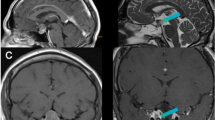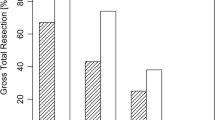Abstract
The use of intraoperative MRI (iMRI) increases extent of resection in transsphenoidal pituitary surgery. Microsurgical and endoscopic techniques have been established as equal and standard surgical methods. The object of the current study was to evaluate the additional value of iMRI for resection of invasive pituitary adenomas. We conducted a retrospective monocenter study of all consecutive patients treated with invasive pituitary adenomas graded as Knosp III-IV at our department after the introduction of iMRI in 2008. Out of 315 transsphenoidal surgeries for pituitary adenomas, 111 met the criteria for analysis. Patients treated with endoscopic or microsurgical technique were included. iMRI was performed at surgeons’ discretion, when maximal safe resection was assumed. Detailed volumetric tumor analysis using semiautomatic segmentation software (Brainlab Elements) before surgery, during surgery, and after surgery was performed. Additionally, demographic data, additional resection, endocrinological outcome as well as complications were evaluated. Postoperative tumor volume as measured in the follow-up MRI 3 months after surgery was significantly lower compared with intraoperative tumor volume (p < 0.001). The difference was statistically significant for both surgical techniques (p < 0.001). No significant difference was found between both techniques in intraoperative and postoperative tumor volume (p = 0.395 and p = 0.329 respectively). Additional tumor resection was performed in 56 cases (50.5%). We found no significant difference between microsurgical and endoscopic techniques regarding additional resection after iMRI (p = 0.512). New diagnosed permanent diabetes insipidus was found in 10 patients (10.5%, 10/95). New hypopituitarism was seen in 22.1% (21/95) cases and according to multivariate logistic regression was significantly associated with microsurgical technique (p = 0.035). Visual improvement was achieved in 76.8% (N = 53/69, p < 0.001) of patients with visual impairment before surgery. Revision surgery as the consequence of cerebrospinal fistula was performed in eight cases (7.2%). Meningitis was documented in three patients (2.7%). One patient died as a consequence of intraoperative vascular injury. Intraoperative MRI after maximal safe resection significantly improves the overall extent of resection in invasive pituitary adenomas independent of the surgical technique employed. Simultaneously, iMRI-assisted transsphenoidal surgery results in excellent visual recovery with low-risk profile for surgical complications for both endoscopic as well as microsurgical technique. Endoscopic technique might be related to the lower incidence of new hypopituitarism after surgery.


Similar content being viewed by others
References
Ammirati M, Wei L, Ciric I (2013) Short-term outcome of endoscopic versus microscopic pituitary adenoma surgery: a systematic review and meta-analysis. J Neurol Neurosurg Psychiatry 84:843–849. https://doi.org/10.1136/jnnp-2012-303194
Bellut D, Hlavica M, Muroi C, Woernle CM, Schmid C, Bernays RL (2012) Impact of intraoperative MRI-guided transsphenoidal surgery on endocrine function and hormone substitution therapy in patients with pituitary adenoma. Swiss Med Wkly 142:w13699. https://doi.org/10.4414/smw.2012.13699
Berkmann S, Schlaffer S, Buchfelder M (2013) Tumor shrinkage after transsphenoidal surgery for nonfunctioning pituitary adenoma. J Neurosurg 119:1447–1452. https://doi.org/10.3171/2013.8.JNS13790
Buchfelder M, Schlaffer S-M (2016) Intraoperative magnetic resonance imaging for pituitary adenomas. Front Horm Res 45:121–132. https://doi.org/10.1159/000442328
Charalampaki P, Ayyad A, Kockro RA, Perneczky A (2009) Surgical complications after endoscopic transsphenoidal pituitary surgery. J Clin Neurosci 16:786–789. https://doi.org/10.1016/j.jocn.2008.09.002
Coburger J, König R, Seitz K, Bäzner U, Wirtz CR, Hlavac M (2014) Determining the utility of intraoperative magnetic resonance imaging for transsphenoidal surgery: a retrospective study. J Neurosurg 120:346–356. https://doi.org/10.3171/2013.9.JNS122207
Dehdashti AR, Ganna A, Karabatsou K, Gentili F (2008) Pure endoscopic endonasal approach for pituitary adenomas: early surgical results in 200 patients and comparison with previous microsurgical series. Neurosurgery 62:1006–1015
Hadad G, Bassagasteguy L, Carrau RL, Mataza JC, Kassam A, Snyderman CH, Mintz A (2006) A novel reconstructive technique after endoscopic expanded endonasal approaches: vascular pedicle nasoseptal flap. Laryngoscope 116:1882–1886. https://doi.org/10.1097/01.mlg.0000234933.37779.e4
Jho HD, Alfieri A (2001) Endoscopic endonasal pituitary surgery: evolution of surgical technique and equipment in 150 operations. Minim Invasive Neurosurg 44:1–12. https://doi.org/10.1055/s-2001-13590
Knosp E, Steiner E, Kitz K, Matula C (1993) Pituitary adenomas with invasion of the cavernous sinus space: a magnetic resonance imaging classification compared with surgical findings. Neurosurgery 33:610–617 – discussion 617–8
Komotar RJ, Starke RM, Raper DMS, Anand VK, Schwartz TH (2011) Endoscopic endonasal compared with microscopic transsphenoidal and open transcranial resection of giant pituitary adenomas. Pituitary 15:150–159. https://doi.org/10.1007/s11102-011-0359-3
Magro E, Graillon T, Lassave J, Castinetti F, Boissonneau S, Tabouret E, Fuentes S, Velly L, Gras R, Dufour H (2016) Complications related to the endoscopic endonasal transsphenoidal approach for nonfunctioning pituitary macroadenomas in 300 consecutive patients. World Neurosurg 89:442–453. https://doi.org/10.1016/j.wneu.2016.02.059
Micko ASG, Wöhrer A, Wolfsberger S, Knosp E (2015) Invasion of the cavernous sinus space in pituitary adenomas: endoscopic verification and its correlation with an MRI-based classification. J Neurosurg 122:803–811. https://doi.org/10.3171/2014.12.JNS141083
Mortini P, Losa M, Barzaghi R, Boari N, Giovanelli M (2005) Results of transsphenoidal surgery in a large series of patients with pituitary adenoma. Neurosurgery 56:1222–1233. discussion 1233. https://doi.org/10.1227/01.NEU.0000159647.64275.9D
Pala A, Knoll A, Brand C, Etzrodt-Walter G, Coburger J, Wirtz CR, Hlavac M (2017) The value of intraoperative MRI in endoscopic and microsurgical transsphenoidal pituitary adenoma resection. World Neurosurgery 102:144–150. https://doi.org/10.1016/j.wneu.2017.02.132
Pomeraniec IJ, Dallapiazza R, Xu Z, Jane J, Jane J Jr, Sheehan JP (2015) 115 early vs late gamma knife radiosurgery following transsphenoidal resection for nonfunctioning pituitary macroadenomas. Neurosurgery 62:202. https://doi.org/10.1227/01.neu.0000467077.55355.a9
Schaberg MR, Anand VK, Schwartz TH, Cobb W (2010) Microscopic versus endoscopic transnasal pituitary surgery. Curr Opin Otolaryngol Head and Neck Surg 18:8–14. https://doi.org/10.1097/MOO.0b013e328334db5b
Schwartz TH, Stieg PE, Anand VK (2006) Endoscopic transsphenoidal pituitary surgery with intraoperative magnetic resonance imaging. Oper Neurosurg 58:ONS–44–ONS–51. https://doi.org/10.1227/01.NEU.0000193927.49862.B6
Serra C, Burkhardt J-K, Esposito G, Bozinov O, Pangalu A, Valavanis A, Holzmann D, Schmid C, Regli L (2016) Pituitary surgery and volumetric assessment of extent of resection: a paradigm shift in the use of intraoperative magnetic resonance imaging. Neurosurg Focus 40:E17. https://doi.org/10.3171/2015.12.FOCUS15564
Starke RM, Raper DMS, Payne SC, Vance ML, Oldfield EH, Jane JA (2013) Endoscopic vs microsurgical transsphenoidal surgery for acromegaly: outcomes in a concurrent series of patients using modern criteria for remission. J Clin Endocrinol Metab 98:3190–3198. https://doi.org/10.1210/jc.2013-1036
Sylvester PT, Evans JA, Zipfel GJ, Chole RA, Uppaluri R, Haughey BH, Getz AE, Silverstein J, Rich KM, Kim AH, Dacey RG, Chicoine MR (2015) Combined high-field intraoperative magnetic resonance imaging and endoscopy increase extent of resection and progression-free survival for pituitary adenomas. Pituitary 18:72–85. https://doi.org/10.1007/s11102-014-0560-2
Webb SM, Rigla M, Wägner A, Oliver B, Bartumeus F (1999) Recovery of hypopituitarism after neurosurgical treatment of pituitary adenomas. J Clin Endocrinol Metab 84:3696–3700. https://doi.org/10.1210/jcem.84.10.6019
Zaidi HA, De Los Reyes K, Barkhoudarian G, Litvack ZN, Bi WL, Rincon-Torroella J, Mukundan S, Dunn IF, Laws ER (2016) The utility of high-resolution intraoperative MRI in endoscopic transsphenoidal surgery for pituitary macroadenomas: early experience in the advanced multimodality image guided operating suite. Neurosurg Focus 40:E18. https://doi.org/10.3171/2016.1.FOCUS15515
Author information
Authors and Affiliations
Corresponding author
Ethics declarations
Conflict of interest
The authors declare that they have no conflict of interest.
Ethical approval
The study was conducted according to the International Declaration of Helsinki. The approval of the local ethics committee has been obtained (Nr.365/18).
Additional information
Publisher’s note
Springer Nature remains neutral with regard to jurisdictional claims in published maps and institutional affiliations.
Rights and permissions
About this article
Cite this article
Hlaváč, M., Knoll, A., Etzrodt-Walter, G. et al. Intraoperative MRI in transsphenoidal resection of invasive pituitary macroadenomas. Neurosurg Rev 42, 737–743 (2019). https://doi.org/10.1007/s10143-019-01102-7
Received:
Revised:
Accepted:
Published:
Issue Date:
DOI: https://doi.org/10.1007/s10143-019-01102-7




